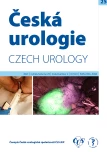Ultrasound versus fluoroscopic localisation during extracorporeal shockwave lithotripsy
Authors:
Michaela Motolová 1; Milan Král 2
Authors‘ workplace:
Urologie, Barmherzige Schwestern Krankenhaus Wien
1; Urologická klinika LF UP a FN Olomouc
2
Published in:
Ces Urol 2021; 25(2): 112-119
Category:
Original Articles
Overview
Motolová M, Král M. Ultrasound guidance versus flouroscopic targeting of urolithiasis by extracorporeal shock wave litotripsy.
Aim: Efficacy comparison of two localization techniques using ESWL – exclusively real time ultrasound or fluoroscopy. Demonstration of at least equivalence of both techniques. To publisize the advantages of real-time ultrasound guidance to encourage more departments in develop of this modality.
Methods: This bicentric retrospective study compares stone free rates (SFRs) in three selected groups of patients with similar characteristics. Inclusion criteria: ESWL as primary intervention for nephrolithiasis, proximal or prevesical uretherolithiasis. The definition of stone free was a patient without any residual stone or the absence of fragments ≥ 2 mm. The arm with exclusively real-time USG targeting of urolithiasis contains a group of 120 patients, using electromagnetic lithotripter – STORZ SLK between 02/2017–02/2020. The fluroscopy - arm includes two groups: 72 patients, using electroconductive lithotripters: Sonolith-i-sys (EDAP) between 04–10/2017 and 68 patients, by using electrohydraulic lithotripter Medilit 7 between 01/2016–03/2017. Simultaneus evaluation of requisite for auxiliary techniques and number of sessions for complete stone-desintegration.
Results: SFR was 90% in the USG-guided group. The avarage number of ESWL sessions was 1,3. SFR in the fluoroscopic arm: the group-Sonolith-i-sys plus the group Medilit 7 was 90%. The avarage number of ESWL sessions was 1,5. These results were not significantly different α = 0,105. The same result is shown on comparson of frequency of requirement for auxiliary techniques – DJ-stent insertion/ureterorenoscopy α = 0,453. Radiation exposure was the biggest difference between techniques, as well as analgesics requirement which were significantly lower in USG arm ( α < 0,001). The operator presence-time was significantly longer in USG – guided ESWL.
Conclusion: Our study shows efficacy equivalence of outcomes of both localization modalities. Real-time USG guidance should be primarily used to reduce radation exposure for patients undergoing ESWL.
Keywords:
Effectivity – extracorporeal shock wave lithotripsy – Radiation exposure – ultrasonography – urolithiasis
Sources
1. Türk C, Neisius A, Petrik A, et al. EAU Guidelines of Urolithiasis 2020 European Association of Urology. Amsterdam, ISBN 978-94-92671-04-2.
2. Abid N, Ravier E, Promeyrat X, et al. Decreased Radiation Exposure and Increased Efficacy in Extracorporeal Lithotripsy Using a New Ultrasound Stone Locking System. J Endourol 2015; 29(11): 1263–1269. DOI: 10.1089/end.2015.0175.
3. Smith HE, Bryant DA, KooNg J, Chapman RA, Lewis G. Extracorporeal shockwave lithotripsy without radiation: Ultrasound localization is as effective as fluoroscopy. Urol Ann 2016; 8(4): 454–457. DOI: 10.4103/0974-7796.192104.
4. Van Besien J, Uvin P, Hermie I, Tailly T, Merckx L. Ultrasonography Is Not Inferior to Fluoroscopy to Guide Extracorporeal Shock Waves during Treatment of Renal and Upper Ureteric Calculi: A Randomized Prospective Study. Biomed Res Int 2017; 2017 : 7802672. DOI: 10.1155/2017/7802672.
5. Hegazy AS, Abdelfattah DM, Hassan HN. Ultrasound guided Extracorporeal Shock Wave Lithotripsy (SONO ESWL) versus fluoroscopy guided ESWL in patients with radiopaque renal stones; A comparative randomized study, QJM: An International Journal of Medicine 2020; 113: Issue Supplement_1. https://doi. org/10.1093/qjmed/hcaa070.013.
6. Kaynar M, Tekinarslan E, Keskin S, et al. Effective radiation exposure evaluation during a one year follow-up of urolithiasis patients after extracorporeal shock wave lithotripsy. Central European Journal of Urology 2015; 68(3): 348–352. DOI: 10.5173/ceju.2015.547.
7. Novák K. Problematika urolitiázy u dětského pacienta: přinesla moderní doba nové možnosti? Urol List 2007; 5(1): 22–25.
8. Goren MR, Goren V, Ozer C. Ultrasound-Guided Shockwave Lithotripsy Reduces Radiation Exposure and Has Better Outcomes for Pediatric Cystine Stones. Urol Int 2017; 98(4): 429–435. DOI: 10.1159/000446220.
Labels
Paediatric urologist Nephrology UrologyArticle was published in
Czech Urology

2021 Issue 2
Most read in this issue
- Transperineal prostate biopsy in the diagnosis of prostate cancer
- Antibiotic prophylaxis in multiparametric magnetic resonance imaging-guided transrectal prostate biopsy
- Posterior urethral valve with late manifestation in a 14-year-old boy
- Laparoscopic partial nephrectomy of solitary kidneys
